Element 5 – Boron
Louis M. Rendina AA School of Chemistry and The University of Sydney Nano Institute, The University of Sydney, Sydney, NSW 2006, Australia. Email: lou.rendina@sydney.edu.au
Australian Journal of Chemistry 72(9) 652-656 https://doi.org/10.1071/CH19300
Submitted: 1 July 2019 Accepted: 4 July 2019 Published: 31 July 2019
‘Boron is my element – not that I own boron, but it owns me’ M. F. Hawthorne
Boron is a group 13 metalloid. It is not found in its elemental form on Earth, but rather it is chemically combined with oxygen and found in numerous borate minerals such as borax (tincal) (Na2[B4O5(OH)4]·8H2O), kernite (rasorite) (Na2[B4O6(OH)2]·3H2O), colemanite (Ca[B3O4(OH)4]·H2O), and ulexite (NaCa[B5O6(OH)6]·5H2O). The largest reserves of boron minerals are found in Turkey, with the country holding an estimated 70 % of total worldwide deposits. Borax has been used as a flux since antiquity, and it has been described in early Latin texts. It was also used as a pottery glaze in China from around 300 AD. The name ‘borax’ is thought to be derived from the Arabic word buraq or Persian word burah (white).
Some volcanic spring waters and vapours from fumaroles, such as those found in Tuscany, Italy, are rich in boric acid (sassolite, H3BO3). The acid or, more likely, the dehydrated form known as metaboric acid (HBO2) was first prepared in 1702 by the German natural philosopher W. Homberg when he combined borax with vitriolic acid (H2SO4),[1] naming the product Sal Sedativum Hombergi (‘sedative salt of Homberg’). As a result of A. Lavoisier’s early work on acids, the term ‘boracic acid’ was used in place of Sal Sedativum, abbreviated later to boric acid.
The year 1808 was a landmark for chemistry as the British chemist J. Dalton first proposed his revolutionary atomic theory, but a lesser known fact is that, in the same year, elemental boron was first isolated in an impure form from boric acid by reduction with potassium metal or electrolysis. Intriguingly, the element was discovered twice: J. L. Gay-Lussac and L. J. Thénard (Paris) used potassium as the reducing agent and reported their discovery first and,[2] independently, Sir Humphry Davy (London) used electrolysis initially (later with potassium) and reported his discovery nine days later.[3] The great irony is that Gay-Lussac and Thénard could not have made their discovery without first isolating potassium metal by electrolysis, the preparation of which was first reported by Davy one year earlier! In 1812, the New England Journal of Medicine and Surgery quoted Davy: ‘…there is strong reason to consider the boracic basis as metallic in its nature; and I venture to propose for it the name of boracium’. The article continues: ‘The conclusions of the French chemists M. M. Gay Lussac and Thenard, respecting the nature of the basis, are somewhat different. They regard it as analogous to sulphur and phosphorus, and have given it the name of bore.’ In 1824, the Swedish chemist J. Berzelius first characterised boron as an element.[4,5] In 1859, the British organometallic chemist E. Frankland prepared the first organoboron compound, triethylborane, by treating triethylborate with an excess of diethylzinc.[6]
Boron’s high propensity for refractory contamination and stoichiometric reactions with many other elements such as carbon is largely the reason why so much confusion in the literature exists, with numerous reports incorrectly claiming the isolation of the pure element.[7] In 1895, the French chemist H. Moissan, who had isolated fluorine nine years earlier, had not only proved that the first reports of boron were in fact based upon highly impure samples, but he also came close to isolating the pure element himself upon reduction of B2O3 with magnesium metal.[8] The purified element was not reported for another century after its initial reports when the Russian-born American chemist E. Weintraub reduced BCl3 with H2 to give high purity (~99 %) boron.[9] It took another 50 years before the first pure boron phase (β-B106) was fully characterised by Sands and Hoard,[10,11] arguably the first report of the pure element 150 years after its initial discovery by Davy, Gay-Lussac, and Thénard. In 2007, β-B106 was shown by means of DFT calculations to be the most thermodynamically stable phase of boron at room temperature.[12] To date, five crystallographically characterised allotropes of the pure element are known (α- and β-rhombohedral, α- and β-tetragonal, and γ-orthorhombic) but at least two amorphous forms along with over a dozen other allotropes of boron have been reported, although it is likely that some are not comprised of the pure element. More recently, new 2D crystalline monolayer (borophene)[13] and fullerene-like 3D (borospherene)[14] boron materials have also been reported, but it was only this year that borophene was first synthesised free of a metal substrate in a scalable manner by means of sonochemical exfoliation.[15] There is little doubt that new boron materials such as borophene and boron nitride nanosheets[16] will play an important role in the ‘post-graphene’ world.
In terms of molecular compounds containing boron, boranes are the second largest group of binary element hydrides (BxHy) after the hydrocarbons, many of which were first prepared by the German chemist A. Stock over several years (1912–1937). But unlike methane, even the simplest boron hydride BH3 exists as the dimeric molecule diborane (1; Chart 1) whose structure cannot be adequately described using a valence-bond description, and multicentered (e.g. 3-centre, 2-electron) bonding must be invoked. Higher boranes, where x > 3, form structurally diverse cluster compounds known as ‘polyhedral boranes’ that are usually incorrectly referred to as ‘electron deficient’. Indeed, many such boranes are thermally stable and many of their structures were predicted before their synthesis.[17] The three-dimensional delocalisation (or ‘pseudo-aromaticity’) of the σ-framework electrons in polyhedral boranes largely accounts for their remarkably robust properties. Numerous types of polyhedral boranes were first prepared by the American chemists E. Muetterties and M. F. Hawthorne, e.g. the icosahedral [B12H12]2− dianion 2 (Chart 1).[18,19] Furthermore, heteroatoms such as carbon could be incorporated into the cluster framework to afford the widely known carboranes,[20] for example. Chemical bonding theories required revision and new sets of electron-counting rules, e.g. polyhedral skeletal electron pair theory, were devised by K. Wade[21] in order to explain the bonding in polyhedral boranes; E. Jemmis[22] later established electron-counting rules for macropolyhedral boranes and elemental boron.[23] Boron continues to intrigue chemists with a new type of conformational isomerism reported for a boron-porphyrin complex.[24]
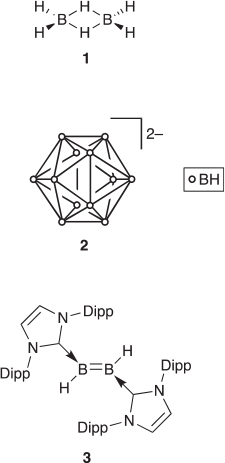
|
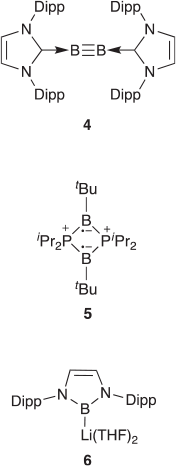
|
If boranes are the group 13 analogues of hydrocarbons, then unsaturated organic molecules such as alkenes and alkynes also have their boron-based analogues. Main group chemists have isolated and characterised numerous types of small molecules with B–B multiple bonding, including anionic and neutral diborenes exhibiting B=B bonding, e.g. 3 (Dipp = 2,6-iPr2C6H3; Chart 1).[25–29] More recently, H. Braunschweig and co-workers reported the first example of a diboryne possessing a formal triple bond between its two boron atoms (4; Chart 2), a significant achievement in the field.[30]
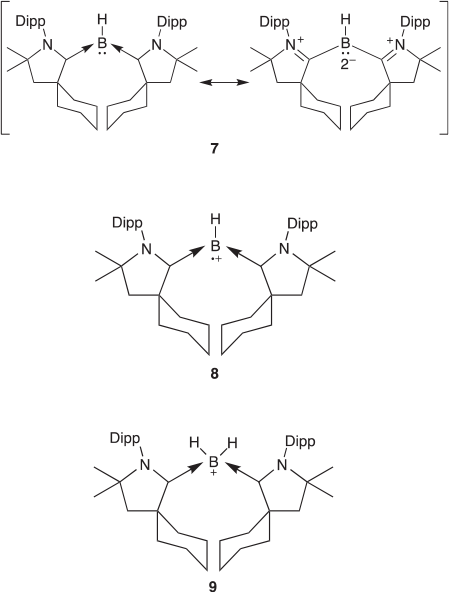
|
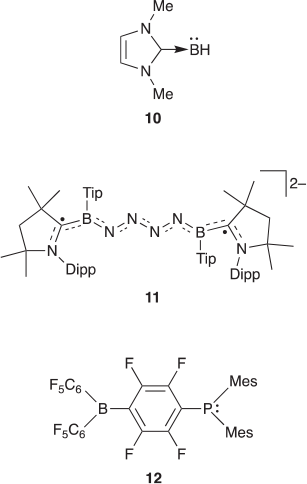
|
Typically, boron has a formal oxidation state of +3 in many of its molecular compounds, e.g. oxides, nitrides, and halides, but lower oxidation states are also accessible. In general, its chemistry is typified by its electrophilicity and ability to act as a Lewis acid. Boron can also greatly stabilise radicals. For example, G. Bertrand and co-workers have isolated a remarkably stable diphosphinodiborane diradical (5; Chart 2).[31] Under certain circumstances, boron can also display ‘umpolung’ behaviour and act as a nucleophile and a Lewis base. Formally, anionic boron derivatives known as boryls are one such example. In these molecules, the boron can act as a potent Lewis base, rather than the more typical Lewis acid, when bonded to an electron-rich N-heterocyclic carbene (NHC). In 2006, M. Yamashita and K. Nozaki reported the first example of boron nucleophile, a NHC-stabilised boryl anion (isolated as its lithium salt 6; Chart 2)[32]; a more-readily accessed magnesium derivative was recently reported.[33] G. Bertrand and co-workers have reported the first example of a borylene 7 (Chart 3) with an electron-rich boron centre which is isoelectronic with secondary amines.[34] One-electron (chemical) oxidation of 7 yielded the borinylium radical cation 8 (Chart 3). Alternatively, protonation of 6 with a strong Brønsted acid afforded the boronium cation 9 (Chart 3). Notably, the free NHC-stabilised B–H borylene 10 (Chart 4) has been prepared in situ from the parent boron dichloride by means of a dehalogenation reaction and trapped with naphthalene.[35] With a lone pair and empty p-orbital, the boron atom in borylenes can bind and activate small molecules such as N2, thus representing the first example of N2 binding and reduction by a non-metal[36]; two molecules of N2 can also be coupled under reductive conditions to afford an unusual [N4]2− chain that bridges two boron centres (11, Tip = 2,4,6-triisopropylphenyl; Chart 4).[37] D. Stephan and co-workers have introduced and exploited a phenomenon termed ‘frustrated Lewis pairs’ (FLPs),[38] whereby sterically hindered Lewis acids based on boron and Lewis bases such as phosphines or amines (e.g. 12; Chart 4) cannot react together to form the expected Lewis acid–base adduct and instead cooperate to activate small molecules such as H2, alkenes, alkynes, NO, CO, CO2, SO2, N2O, silanes, and C(sp2)–H bonds. Their potential as metal-free catalysts is the subject of intensive research. H. Braunschweig and co-workers have proposed that the boron atom in reactive molecules such as borylenes and FLPs can act as a ‘metallomimetic’ main group element, with numerous examples and mechanisms discussed in a recent comprehensive review.[39]
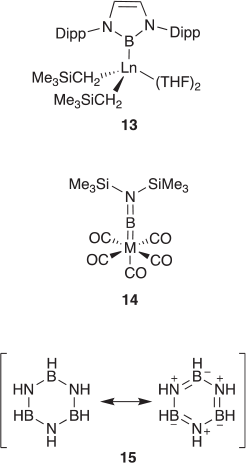
|
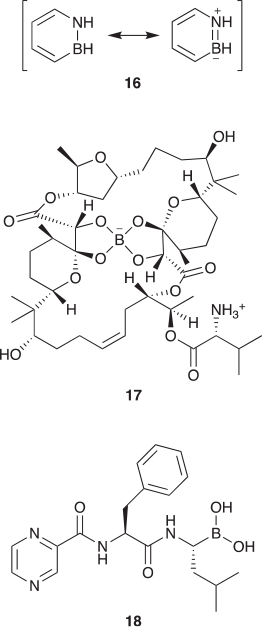
|
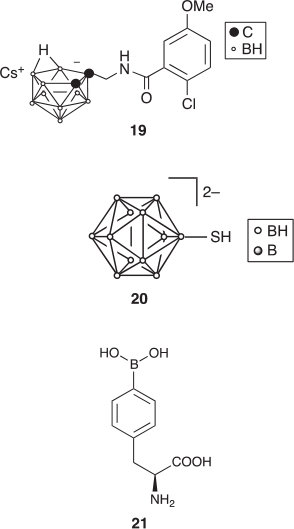
|
A. Hill and co-workers first demonstrated the boron atom in a borane ligand is directly involved in the formation of a coordinate-covalent bond with an electron-rich, transition metal (M→BR3).[40] Coordination of B-H bonds at transition metal centres, and their subsequent activation to give boryl and borylene ligands are the subjects of intense study by numerous groups.[41] The formally anionic boryl ligand (BR2–) is a potent 2-electron, σ-donor (M–BR2),[42] and the borylene (:BR) ligand is isoelectronic with CO.[43] An important breakthrough in the field, reported by C. Jones, S. Aldridge, P. Mountford, and co-workers, involved the first examples of lanthanoid (f-block) complexes containing a boryl ligand, e.g. 13 (Ln = Lu, Y; Chart 5).[44] H. Braunschweig and co-workers reported the first stable terminal borylene complexes 14 (M = Cr, W; Chart 5).[45]
The B–N bond is isosteric and isoelectronic with the C–C bond and many examples of so-called ‘BN/CC isosterism’ are known.[46] The classic example is borazine 15 (also known as ‘inorganic benzene’; Chart 5), the stable B–N analogue of benzene, prepared by a reaction of diborane with ammonia.[47] Liu and co-workers have exploited this concept in their studies involving 1,2-azaborines 16 (Chart 6) and related analogues, including a comprehensive study of their potential applications in materials science and medicinal chemistry.[48]
Boric acid has been used for many years as an eye-wash and mild antiseptic, and several naturally occurring antibiotics containing boron, e.g. boromycin 17, are known (Chart 6).[49] Boron is an essential plant micronutrient and there is some evidence it is required for the maintenance of bone health in mammals.[49] The discovery of ‘first-in-class’ drug leads and biological sensors based upon boronic acids, boronates, benzoxaboroles, carboranes, boron-dipyrromethene (BODIPY) and 1,2-azaborines will likely play key roles in the drug discovery pipeline and chemical biology, thereby cementing boron’s place as an important element in the medicinal chemist’s or chemical biologist’s toolbox.[50–58] To date, three potent therapeutics containing boron are now used routinely in the clinic: bortezomib (18, Velcade®; Chart 6) for the treatment of multiple myeloma; tavaborole (Kerydin®) for the treatment of onychomycosis, a fungal infection of the nail and nail bed; and crisaborole (Eucrisa®) for the treatment of atopic dermatitis. Several other boron-based drugs are currently in pre-clinical and clinical phases of assessment, including the first CNS-active carborane 19 (Chart 7).[59] Finally, the nucleus of the naturally occurring and non-radioactive 10B isotope has a high affinity for thermal neutrons, a feature that has been exploited for several decades in an experimental cancer therapy known as boron neutron capture therapy (BNCT) used in the treatment of patients with intractable and aggressive cancers such as malignant brain cancers and melanoma.[60] Two 10B-enriched BNCT agents, borocaptate ion (BSH, 20; Chart 7) and p-borono-L-phenylalanine (BPA, 21; Chart 7), are used clinically.
The rich and diverse chemistry of boron is unique and it has frustrated, challenged, and enlightened chemists for over two centuries. The element has given rise to completely new paradigms of chemical reactivity and bonding, and it has transformed synthesis, materials science, and medicinal chemistry. To date, boron has been central to three Nobel prizes in chemistry awarded to W. Lipscomb (1976), H. C. Brown (1979), and A. Suzuki (2010). Along with main group chemistry as a whole,[61] boron is currently experiencing a renaissance, and many new and exciting discoveries involving this element are assured in the future. The discipline of chemistry as a whole can only benefit from such discoveries.
Conflicts of Interest
The author declares no conflicts of interest.
Acknowledgements
Over the past two decades, I have had the privilege of working with many dedicated and talented Honours and postgraduate students, postdoctoral researchers and collaborators from throughout Australia and internationally – I sincerely wish to thank them all. I also wish to thank the numerous funding agencies, particularly the Australian Research Council, Cure Cancer Foundation of Australia, National Breast Cancer Foundation, and the Prostate Cancer Foundation of Australia, for past and current funding of our boron research.
References
[1] W. Homberg, ‘Essays de Chimie. Article Premier: Des Principes de la Chemie en general’, Mémoires de l’Académie royale de sciences, 1702, 33.[2] J. L. Gay-Lussac, L. J. Thénard, Ann. Chim. Phys. 1808, 68, 169.
[3] H. Davy, Philos. Trans. R. Soc. Lond. B Biol. Sci. 1808, 98, 333.
| Crossref | GoogleScholarGoogle Scholar |
[4] J. Berzelius, Kongliga Vetenskaps-Academiens Handlingar 1824, 12, 46.
[5] J. Berzelius, Poggendorff’s Annalen der Physik und Chemie 1824, 78, 113.
| Crossref | GoogleScholarGoogle Scholar |
[6] E. Frankland, B. F. Duppa, Justus Liebigs Ann. Chem. 1860, 115, 319.
| Crossref | GoogleScholarGoogle Scholar |
[7] P. Ball, Nat. Mater. 2010, 9, 6.
| Crossref | GoogleScholarGoogle Scholar | 20019661PubMed |
[8] H. Moissan, Ann. Chim. Phys. 1895, 6, 296.
[9] E. Weintraub, Trans Am. Electrochem. Soc 1909, 16, 165.
[10] D. E. Sands, J. L. Hoard, J. Am. Chem. Soc. 1957, 79, 5582.
| Crossref | GoogleScholarGoogle Scholar |
[11] R. E. Hughes, C. H. L. Kennard, D. B. Sullenger, H. A. Weakliem, D. E. Sands, J. L. Hoard, J. Am. Chem. Soc. 1963, 85, 361.
| Crossref | GoogleScholarGoogle Scholar |
[12] M. J. van Setten, M. A. Uijttewaal, G. A. de Wijs, R. A. de Groot, J. Am. Chem. Soc. 2007, 129, 2458.
| Crossref | GoogleScholarGoogle Scholar | 17295480PubMed |
[13] B. Feng, J. Zhang, Q. Zhong, W. Li, S. Li, H. Li, P. Cheng, S. Meng, L. Chen, K. Wu, Nat. Chem. 2016, 8, 563.
| Crossref | GoogleScholarGoogle Scholar | 27219700PubMed |
[14] H.-J. Zhai, Y.-F. Zhao, W.-L. Li, Q. Chen, H. Bai, H.-S. Hu, Z. A. Piazza, W.-J. Tian, H.-G. Lu, Y.-B. Wu, Y.-W. Mu, G.-F. Wei, Z.-P. Liu, J. Li, S.-D. Li, L.-S. Wang, Nat. Chem. 2014, 6, 727.
| Crossref | GoogleScholarGoogle Scholar | 25054944PubMed |
[15] P. Ranjan, T. K. Sahu, R. Bhushan, S. S. R. K. C. Yamijala, D. J. Late, P. Kumar, A. Vinu, Adv. Mater. 2019, 1900353.
| Crossref | GoogleScholarGoogle Scholar | 31044470PubMed |
[16] F. Xiao, Z. Chen, G. Casillas, C. Richardson, H. Lie, Z. Huang, Chem. Commun. 2016, 52, 3911.
| Crossref | GoogleScholarGoogle Scholar |
[17] H. C. Longuet-Higgins, M. de V. Roberts, Proc. R. Soc. Lond. A Math. Phys. Sci. 1955, 230, 110.
[18] A. R. Pitochelli, M. F. Hawthorne, J. Am. Chem. Soc. 1960, 82, 3228.
| Crossref | GoogleScholarGoogle Scholar |
[19] E. L. Muetterties, J. H. Balthis, Y. T. Chia, W. H. Knoth, H. C. Miller, Inorg. Chem. 1964, 3, 444.
| Crossref | GoogleScholarGoogle Scholar |
[20] R. N. Grimes, Carboranes, 3rd edn 2016 (Elsevier: Amsterdam).
[21] K. Wade, J. Chem. Soc. D 1971, 792.
| Crossref | GoogleScholarGoogle Scholar |
[22] E. D. Jemmis, M. M. Balakrishnarajan, P. D. Pancharatna, J. Am. Chem. Soc. 2001, 123, 4313.
| Crossref | GoogleScholarGoogle Scholar | 11457198PubMed |
[23] A. J. Welch, Chem. Commun. 2013, 49, 3615.
| Crossref | GoogleScholarGoogle Scholar |
[24] (a) P. J. Canfield, I. M. Blake, Z.-L. Cai, I. J. Luck, E. Krausz, R. Kobayashi, J. R. Reimers, M. J. Crossley, Nat. Chem. 2018, 10, 615.
| Crossref | GoogleScholarGoogle Scholar | 29784991PubMed |
(b) P. J. Brothers, Inorg. Chem. 2011, 50, 12374.
| Crossref | GoogleScholarGoogle Scholar |
[25] H. Klusik, A. Berndt, Angew. Chem. Int. Ed. Engl. 1981, 20, 870.
| Crossref | GoogleScholarGoogle Scholar |
[26] A. Moezzi, R. A. Bartlett, P. P. Power, Angew. Chem. Int. Ed. Engl. 1992, 31, 1082.
| Crossref | GoogleScholarGoogle Scholar |
[27] A. Moezzi, M. M. Olmstead, P. P. Power, J. Am. Chem. Soc. 1992, 114, 2715.
| Crossref | GoogleScholarGoogle Scholar |
[28] W. J. Grigsby, P. P. Power, Chem. Commun. 1996, 2235.
| Crossref | GoogleScholarGoogle Scholar |
[29] Y. Wang, B. Quillian, P. Wei, C. S. Wannere, Y. Xie, R. B. King, H. F. Schaefer, P. R. Schleyer, G. H. Robinson, J. Am. Chem. Soc. 2007, 129, 12412.
| Crossref | GoogleScholarGoogle Scholar | 17887683PubMed |
[30] H. Braunschweig, R. D. Dewhurst, K. Hammond, J. Mies, K. Radacki, A. Vargas, Science 2012, 336, 1420.
| Crossref | GoogleScholarGoogle Scholar | 22700924PubMed |
[31] D. Scheschkewitz, H. Amii, H. Gornitzka, W. W. Schoeller, D. Bourissou, G. Bertrand, Science 2002, 295, 1880.
| Crossref | GoogleScholarGoogle Scholar | 11884750PubMed |
[32] Y. Segawa, M. Yamashita, K. Nozaki, Science 2006, 314, 113.
| Crossref | GoogleScholarGoogle Scholar | 17023656PubMed |
[33] A.-F. Pécharman, A. L. Colebatch, M. S. Hill, C. L. McMullin, M. F. Mahon, C. Weetman, Nature Commun. 2017, 8, 15022.
| Crossref | GoogleScholarGoogle Scholar |
[34] R. Kinjo, B. Donnadieu, M. A. Celik, G. Frenking, G. Bertrand, Science 2011, 333, 610.
| Crossref | GoogleScholarGoogle Scholar | 21798945PubMed |
[35] P. Bissinger, H. Braunschweig, K. Kraft, T. Kupfer, Angew. Chem. Int. Ed. 2011, 50, 4704.
| Crossref | GoogleScholarGoogle Scholar |
[36] M.-A. Légaré, G. Bélanger-Chabot, R. D. Dewhurst, E. Welz, I. Krummenacher, B. Engels, H. Braunschweig, Science 2018, 359, 896.
| Crossref | GoogleScholarGoogle Scholar | 29472479PubMed |
[37] M.-A. Légaré, M. Rang, G. Bélanger-Chabot, J. I. Schweizer, I. Krummenacher, R. Bertermann, M. Arrowsmith, M. C. Holthausen, H. Braunschweig, Science 2019, 363, 1329.
| Crossref | GoogleScholarGoogle Scholar | 30898929PubMed |
[38] D. W. Stephan, Science 2016, 354, aaf7229.
| Crossref | GoogleScholarGoogle Scholar | 27940818PubMed |
[39] M.-A. Légaré, C. Pranckevicius, H. Braunschweig, Chem. Rev. 2019,
| Crossref | GoogleScholarGoogle Scholar | 30640447PubMed |
[40] A. F. Hill, G. R. Owen, A. J. P. White, D. J. Williams, Angew. Chem. Int. Ed. 1999, 38, 2759.
| Crossref | GoogleScholarGoogle Scholar |
[41] H. Kameo, H. Nakazawa, Chem. Asian J. 2013, 8, 1720.
| Crossref | GoogleScholarGoogle Scholar | 23737040PubMed |
[42] G. J. Irvine, M. J. G. Lesley, T. B. Marder, N. C. Norman, C. R. Rice, E. G. Robins, W. R. Roper, G. R. Whittell, L. J. Wright, Chem. Rev. 1998, 98, 2685.
| Crossref | GoogleScholarGoogle Scholar | 11848976PubMed |
[43] (a) D. Vidovic, G. A. Pierce, S. Aldridge, Chem. Commun. 2009, 1157.
| Crossref | GoogleScholarGoogle Scholar |
(b) H. Braunschweig, R. D. Dewhurst, V. H. Gessnera, Chem. Soc. Rev. 2013, 42, 3197.
| Crossref | GoogleScholarGoogle Scholar |
[44] L. M. A. Saleh, K. H. Birjkumar, A. V. Protchenko, A. D. Schwarz, S. Aldridge, C. Jones, N. Kaltsoyannis, P. Mountford, J. Am. Chem. Soc. 2011, 133, 3836.
| Crossref | GoogleScholarGoogle Scholar |
[45] H. Braunschweig, C. Kollann, U. Englert, Angew. Chem. Int. Ed. 1998, 37, 3179.
| Crossref | GoogleScholarGoogle Scholar |
[46] P. G. Campbell, A. J. V. Marwitz, S.-Y. Liu, Angew. Chem. Int. Ed. 2012, 51, 6074.
| Crossref | GoogleScholarGoogle Scholar |
[47] A. Stock, E. Pohland, Ber. Dtsch. Chem. Ges. 1926, 59, 2215.
| Crossref | GoogleScholarGoogle Scholar |
[48] Z. X. Giustra, S.-Y. Liu, J. Am. Chem. Soc. 2018, 140, 1184.
| Crossref | GoogleScholarGoogle Scholar | 29314835PubMed |
[49] I. Uluisik, H. C. Karakaya, A. Koc, J. Trace Elem. Med. Biol. 2018, 45, 156.
| Crossref | GoogleScholarGoogle Scholar | 29173473PubMed |
[50] Boron-Based Compounds: Potential and Emerging Applications in Medicine (Eds E. Hey-Hawkins, C. Viñas Teixidor) 2018 (Wiley: Hoboken, NJ)
[51] C. T. Liu, J. W. Tomsho, S. J. Benkovic, Bioorg. Med. Chem. 2014, 22, 4462.
| Crossref | GoogleScholarGoogle Scholar | 24864040PubMed |
[52] F. Yang, M. Zhu, J. Zhang, H. Zhou, Med. Chem. Commun. 2018, 9, 201.
| Crossref | GoogleScholarGoogle Scholar |
[53] A. Adamczyk-Woźniak, K. M. Borys, A. Sporzyński, Chem. Rev. 2015, 115, 5224.
| Crossref | GoogleScholarGoogle Scholar | 26017806PubMed |
[54] D. B. Diaz, A. K. Yudin, Nat. Chem. 2017, 9, 731.
| Crossref | GoogleScholarGoogle Scholar | 28754930PubMed |
[55] F. Issa, M. Kassiou, L. M. Rendina, Chem. Rev. 2011, 111, 5701.
| Crossref | GoogleScholarGoogle Scholar | 21718011PubMed |
[56] M. Scholz, E. Hey-Hawkins, Chem. Rev. 2011, 111, 7035.
| Crossref | GoogleScholarGoogle Scholar | 21780840PubMed |
[57] P. Stockmann, M. Gozzi, R. Kuhnert, M. B. Sárosi, E. Hey-Hawkins, Chem. Soc. Rev. 2019, 48, 3497.
| Crossref | GoogleScholarGoogle Scholar | 31214680PubMed |
[58] J. Kahlert, C. J. D. Austin, M. Kassiou, L. M. Rendina, Aust. J. Chem. 2013, 66, 1118.
| Crossref | GoogleScholarGoogle Scholar |
[59] S. M. Wilkinson, H. Gunosewoyo, M. L. Barron, A. Boucher, M. McDonnell, P. Turner, D. E. Morrison, M. R. Bennett, I. S. McGregor, L. M. Rendina, M. Kassiou, ACS Chem. Neurosci. 2014, 5, 335.
| Crossref | GoogleScholarGoogle Scholar | 24689484PubMed |
[60] R. F. Barth, Z. Zhang, T. Liu, Cancer Commun. 2018, 38, 36.
| Crossref | GoogleScholarGoogle Scholar |
[61] R. L. Melen, Science 2019, 363, 479.
| Crossref | GoogleScholarGoogle Scholar | 30705183PubMed |


